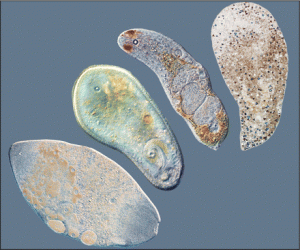We often say that the movement is life. For plankton organisms it is really true. Plankton are any organisms that live in the water column and cannot swim against a current. They have to control ciliary activity to stay at a certain depth.
Depth is so important for the plankton organisms because several environmental factors (temperature, light intensity, the magnitude of UV damage, phytoplankton abundance) change with depth. Swimming depth influences the speed of organisms’ development and success of feeding . Ciliary swimming is used by the larval stage of many marine invertebrates with a benthic adult. Such ciliated larvae are widespread in the animal kingdom. Among the bilaterians, the lophotrochozoans (e.g., annelids and molluscs) and the deuterostomes (e.g., echinoderms and hemichordates) often have ciliated larvae, while the ecdysozoans (e.g., insects and nematodes) lack them. Outside the bilaterians, cilia-based locomotion is present in ctenophores and in the larval stages of many cnidarians. Sponges, the basal-most animal group relative to the eumetazoans, often have ciliated larvae. Freely swimming ciliated larvae often spend days to months as part of the zooplankton. The body orientation is maintained either by passive (buoyancy) or active (gravitaxis, phototaxis) mechanisms. When cilia beat, larvae swim upward, and when cilia cease beating, the negatively buoyant larvae sink. The alternation of active upward swimming and passive sinking, together with swimming speed and sinking rate, determine vertical distribution in the water.
Recent investigations of Markus Conzelmann and his colleagues from Max Planck Institute for Developmental Biology, Germany have shown that neuropeptides are involved in the regulation of ciliary beating. Neuropeptides have a wide range of functions in the control of neural circuits and physiology, including the modulation of locomotion and rhythmic pattern generation, presynaptic facilitation and remodelling of sensory networks, and the regulation of reproduction. Neuropeptide expression data revealed a cellular resolution molecular map of sensory neurons in the 48 hours after fertilization Platynereis larva. Many neuropeptides also showed intense labelling in the apical neurosecretory plexus of the larva, indicating that they may as well be released there. The innervation of the ciliary band by the diverse neuropeptidergic sensory neurons suggests that these cells, in addition to having a possible neurosecretory function, are involved in the direct motor control of the ciliary band and that there is extensive peptidergic regulation during ciliary swimming. Experiments show that Platynereis neuropeptides have strong and sequence-specific effects on two parameters of larval ciliary activity: ciliary beat frequency and ciliary arrests. By influencing ciliary beat frequency and ciliary arrests, neuropeptides can change the eventual movement direction, leading to large shifts in the vertical distribution of populations of ciliated larvae.
Ciliary arrests and beat frequency affect larval swimming. Arrests allow larvae to sink and contribute to the maintenance of an unbiased net vertical displacement. Arrests also lead to irregular swimming tracks. Ciliary beating promotes upward swimming. Neuropeptides can influence both parameters, thereby modulating swimming directionality, the frequency of sinking events, and swimming pattern.
Investigation shows that ciliated larvae use a very simple functional way of regulating swimming by direct sensory-motor innervation.
Such sensory-motor neurons are common in cnidarians. In bilaterians they have been described only in ciliated larvae. This observation raises the interesting possibility that ciliary locomotor circuits in bilaterian larvae have retained an ancestral state of nervous system organization. If this assumption is true, ciliated larval circuitry may give insights into the evolutionary origin of the first nervous systems. The cilia regulatory neuropeptides studied by Markus Conzelmann are widely conserved among marine invertebrates, including other annelids, mollusks, and cnidarians. Because all of these groups have ciliated larvae, these results have broad implications for understanding ciliary locomotor control in a wide range of invertebrate larvae.
Report by Lena Belikova









